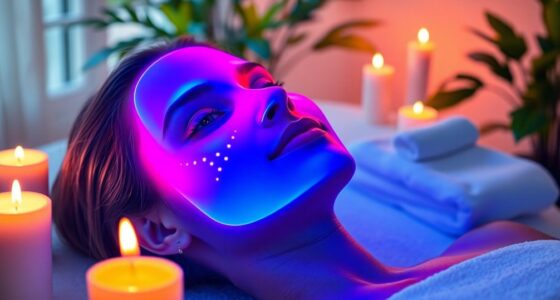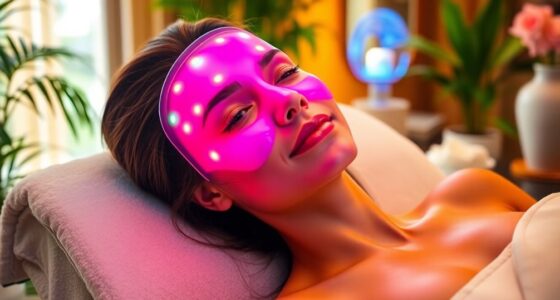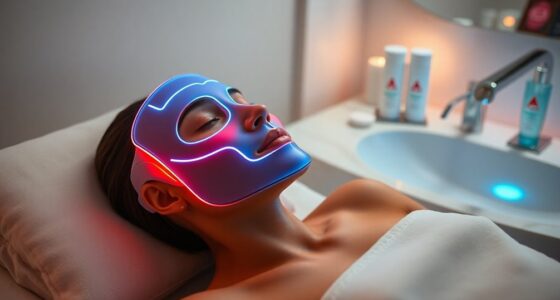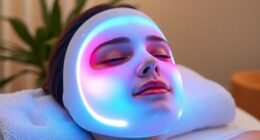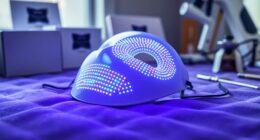LED face masks can be safe and effective if used correctly, but there are some risks to take into account. It’s essential to consult a dermatologist, especially if you have light sensitivity. Always choose FDA-approved devices and prioritize eye protection to avoid irritation. While they may help with skin issues, results can vary based on individual skin types and treatment duration. To learn more about maximizing benefits and minimizing risks, continue exploring all the important safety tips and insights.
Key Takeaways
- LED face masks are FDA approved, ensuring they meet safety standards for skin treatments.
- Consultation with a dermatologist is essential, especially for individuals with light sensitivity or eye disorders.
- Proper eye protection is crucial to prevent irritation and blurry vision from prolonged exposure to blue light.
- Overuse may lead to mild side effects such as redness, irritation, and increased sensitivity, particularly in acne-prone skin.
- Individual skin characteristics can significantly impact treatment outcomes, making personalized recommendations important for safety.
Understanding LED Face Masks
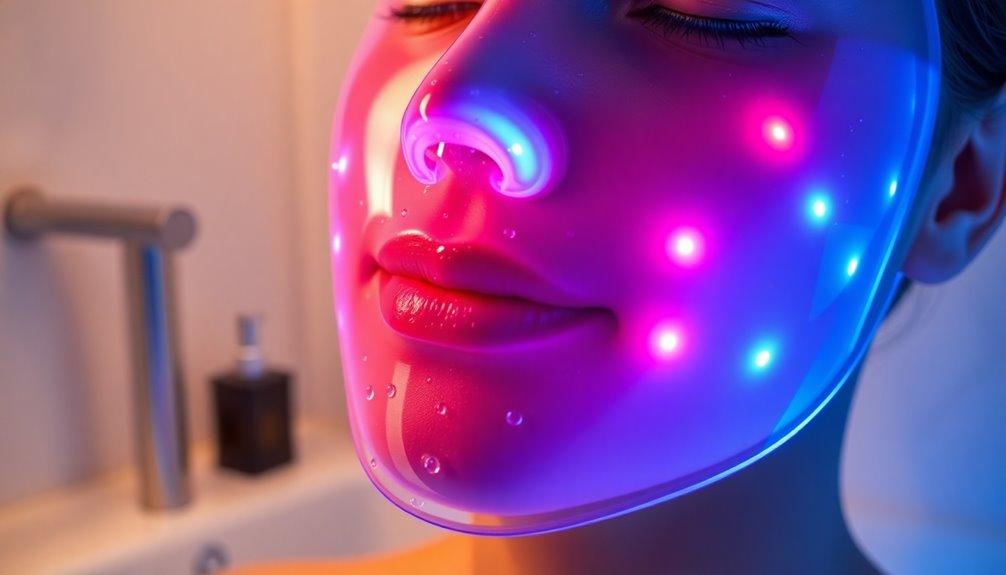
When it comes to skincare technology, LED face masks have gained popularity for their potential benefits, particularly in treating various skin issues.
These devices are generally considered safe for most users and are FDA approved, which means they meet significant safety standards. However, if you have light sensitivity, it’s wise to consult a dermatologist before using one.
Eye protection is vital during treatments involving blue light, as prolonged exposure can lead to eye irritation or injury. While most masks are designed to minimize direct eye contact, some spillover light can still pose risks.
Keep in mind that overusing LED face masks may cause mild side effects like irritation or redness, so always follow the manufacturer’s guidelines for usage time. Additionally, those with acne-prone skin may find that incorporating other treatments, like pimple patches, can enhance their overall skincare routine.
Safety Considerations for Use

Although LED face masks offer many benefits, it’s vital to prioritize safety during their use. If you have light sensitivity or specific eye disorders, consult a dermatologist beforehand.
Verify you’re using FDA-cleared LED masks to minimize risks and comply with safety standards. Eye protection is important, especially when using blue light, as prolonged exposure can lead to serious eye issues.
Be mindful of potential side effects like irritation, redness, or discomfort, which can occur if you use the masks excessively or incorrectly. Always follow the manufacturer guidelines for usage to guarantee a safe experience.
Eye Protection and Risks
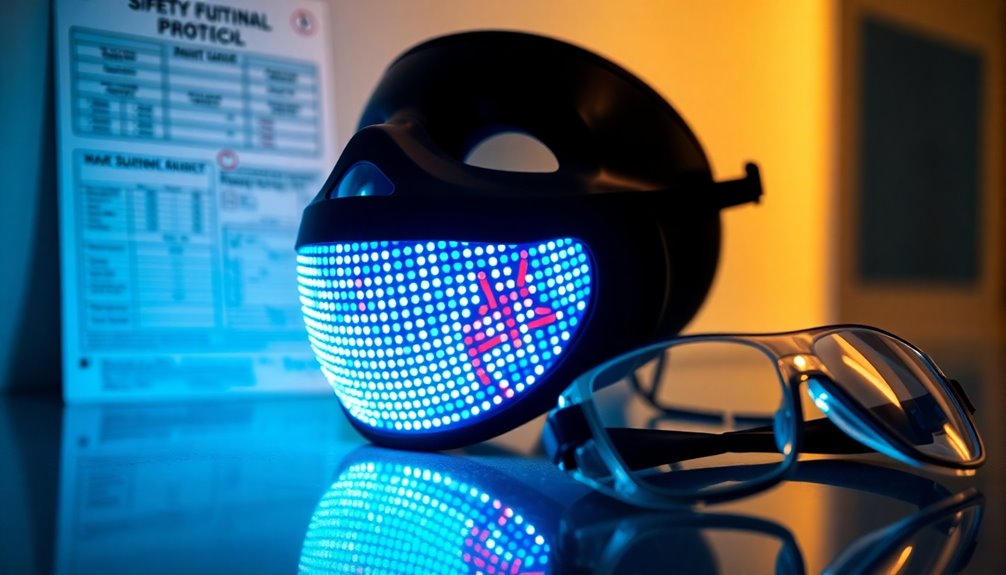
How can you guarantee your eyes stay safe while using LED face masks? Eye protection is essential, especially considering blue light exposure can lead to serious eye issues like blurry vision and eye pain. To safeguard your vision, always wear blackout or opaque goggles during treatment. Prolonged exposure without protection heightens risks, particularly for those with pre-existing eye conditions, so individual assessments are important.
| Risk Factor | Description | Protection Measure |
|---|---|---|
| Blue Light Exposure | Can damage eyes over time | Use blackout goggles |
| Blurry Vision | May result from prolonged exposure | Limit session duration |
| Eye Pain | Discomfort from light spillover | guarantee proper fit of goggles |
| Eye Disorders | Certain conditions increase risk | Consult with an eye specialist |
| Safety Design | Some products have been recalled for risks | Choose reputable brands |
Potential Side Effects
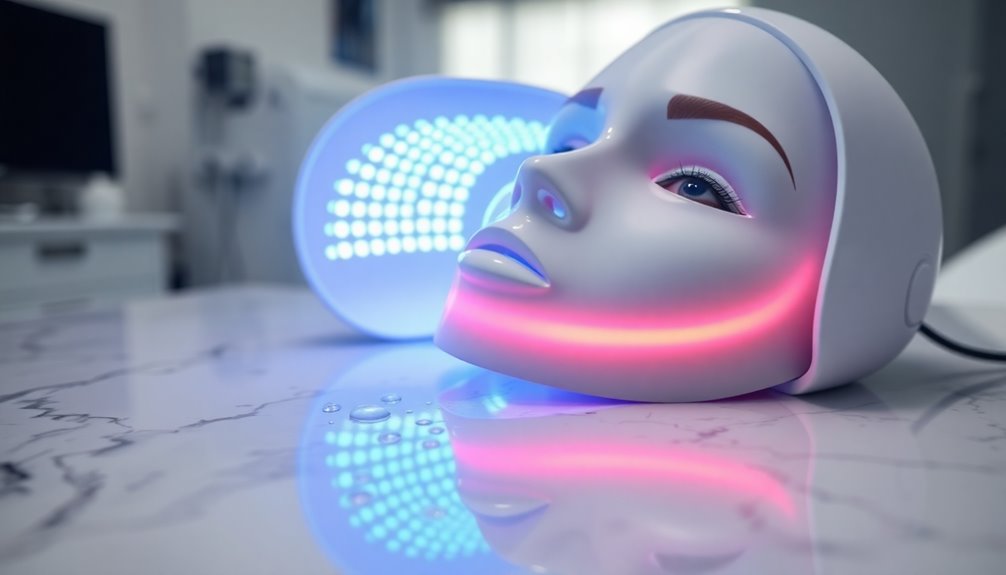
While LED face masks offer various skin benefits, they can also cause potential side effects that users should be aware of.
Here are some side effects to contemplate:
- Eye Irritation: Without proper eye protection, you might experience discomfort or irritation.
- Temporary Blurry Vision: Some users report temporary blurry vision during or after use.
- Light Sensitivity: Individuals with light sensitivity should approach LED masks cautiously to avoid adverse reactions.
- Skin Conditions: Overuse or misuse can lead to increased redness and inflammation, especially for those with existing skin conditions.
Consulting with a dermatologist is advisable if you have any underlying skin or eye conditions before starting LED mask treatments.
Taking these precautions can help you enjoy the benefits while minimizing risks.
Recommendations for Safe Usage

To enjoy the benefits of LED face masks without the risks, it’s important to follow some key recommendations for safe usage.
First, choose LED masks labeled as FDA-cleared to guarantee they meet safety standards and minimize potential risks.
Always protect your eyes by using blackout or opaque goggles, especially when using blue light, to prevent any harmful exposure.
Follow the manufacturer’s instructions closely regarding recommended usage times to avoid irritation or redness from overuse.
If you have specific eye conditions, consult a dermatologist before using LED masks to assess potential risks.
Finally, monitor your skin’s response during treatment and discontinue use immediately if you experience any adverse reactions, like increased inflammation or discomfort.
Effectiveness and Limitations
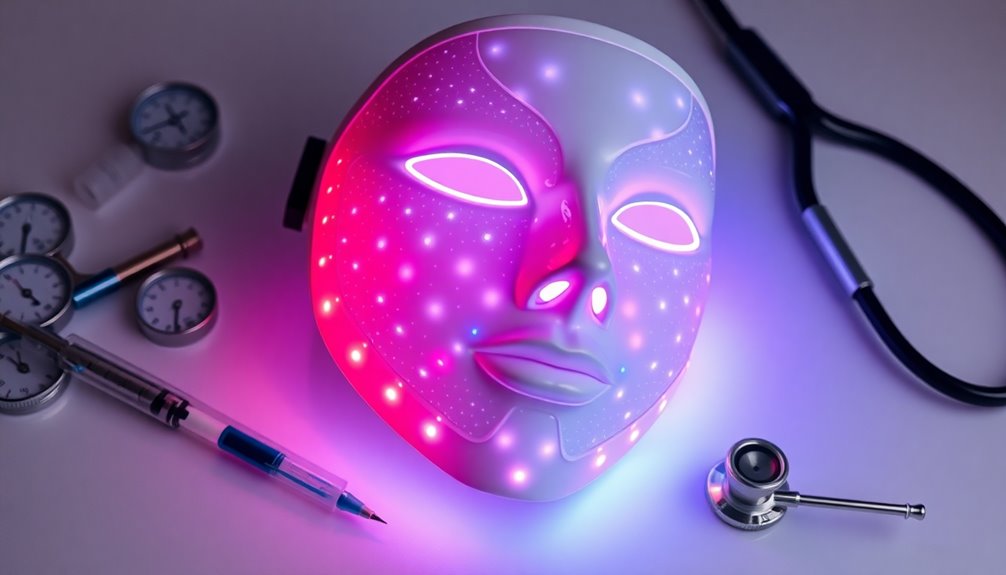
When considering LED face masks, it’s important to understand their effectiveness compared to professional treatments.
While at-home devices can improve skin texture, results can vary considerably based on your skin type and the specific issues you’re targeting.
You’ll want to keep in mind that clinical studies show limited long-term efficacy and that regular, consistent use is key to seeing any benefits.
Clinical Study Results
Clinical studies have shown that LED face masks can subtly improve skin texture and reduce wrinkles, yet individual results often vary due to factors like device quality and usage frequency.
Here’s what you need to know:
- Collagen Synthesis: LED therapy enhances collagen production, promoting firmer skin.
- Cumulative Effects: Continuous use over several weeks is essential for visible improvements.
- Device Power: At-home devices generally yield less effectiveness than professional treatments.
- Skin Type Variation: Efficacy can differ across skin types, with limited research on darker skin tones.
While LED masks can provide subtle improvements, long-term benefits remain unverified, emphasizing the need for ongoing clinical studies to better understand their full potential.
At-Home vs. Professional
While at-home LED face masks offer convenience and affordability, they often fall short compared to professional treatments regarding effectiveness. At-home LED masks deliver less powerful treatments, resulting in subtle improvements over time. In contrast, professional devices provide more significant and immediate results, addressing specific skin concerns with personalized care.
| At-Home LED Masks | Professional Treatments |
|---|---|
| Cost-effective | More expensive |
| Subtle improvements | Immediate results |
| Requires regular use | Single session effectiveness |
Ultimately, while at-home options are accessible and safer, their effectiveness can vary based on usage frequency and device quality. For those seeking pronounced results, professional treatments may be the better choice.
Individual Skin Variability
Because individual skin characteristics vary widely, the effectiveness of LED face masks can differ considerably from person to person.
Here are some factors to evaluate:
- Skin Type: Oily, dry, or combination skin can react differently to light therapy.
- Skin Conditions: Issues like cystic acne or sensitivities may not respond well to LED masks.
- Age: Your age can influence skin elasticity and treatment outcomes.
- Darker Skin Tones: Limited research shows these may be more prone to discoloration from light therapies.
Consulting a dermatologist can help you navigate these variables and tailor a treatment plan.
While regular use is essential, results might be subtle, reflecting your unique skin variability rather than dramatic transformations.
Special Considerations for Skin Types
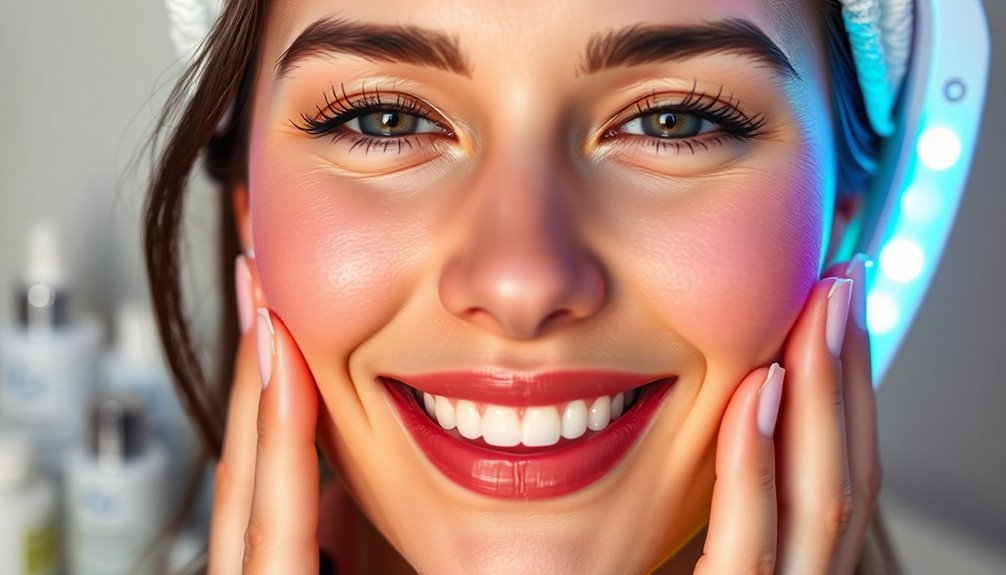
When using LED face masks, it’s essential to take into account your skin type.
If you have darker skin, you might be more prone to discoloration, so you’ll want to use the mask cautiously.
Additionally, if you’re dealing with acne-prone or aging skin, specific light therapies can either help or irritate, making it important to choose wisely.
Darker Skin Sensitivity
Understanding how LED face masks affect darker skin tones is vital, as limited research raises concerns about potential discoloration and adverse reactions.
Individuals with darker skin may experience unique sensitivity, so consider these factors before using LED masks:
- Discoloration Risks: Light therapy can trigger discoloration in darker skin, particularly with certain wavelengths.
- Post-Inflammatory Hyperpigmentation: You may be more prone to this reaction, necessitating caution.
- Consult a Dermatologist: Always seek professional advice to assess potential risks before starting treatment.
- Monitor Reactions: Keep an eye on any changes in your skin after using LED masks.
Since more extensive studies are needed, it’s important to prioritize your skin’s health and safety.
Acne-Prone Skin Reactions
How can using LED face masks affect acne-prone skin?
If you have acne-prone skin, you might face increased sensitivity to LED light, especially blue light, which targets acne-causing bacteria.
While blue light therapy can effectively treat acne, prolonged exposure can lead to irritation and redness, potentially worsening your condition.
To minimize adverse reactions, it’s important to start with shorter treatment durations and carefully monitor your skin’s response.
If you have darker skin tones, be cautious, as limited research exists on LED effects, and you may be more susceptible to post-inflammatory hyperpigmentation.
Consulting a dermatologist before using LED masks is highly recommended to guarantee safe and effective treatment tailored to your unique skin needs.
Aging Skin Considerations
While aging skin often shows signs of wear and tear, LED face masks can offer rejuvenating benefits, particularly through red and near-infrared light.
Here are some important considerations for you:
- Boost Collagen Production: Regular use can enhance collagen, improving skin elasticity.
- Monitor Skin Sensitivity: Aging skin may react differently, so start with shorter sessions.
- Consult a Dermatologist: Especially if you have darker skin tones, professional advice is essential to avoid discoloration.
- Prioritize Eye Protection: Protect your eyes, as LED exposure can worsen existing conditions.
Consulting With a Dermatologist

Before diving into the world of LED face masks, it’s wise to consult with a dermatologist, especially if you have specific skin concerns. A dermatologist can evaluate your skin type and any existing conditions to guarantee the therapy is safe for you.
They’ll provide personalized recommendations, helping you understand the differences between at-home LED masks and in-office treatments, which often yield better results.
Additionally, your dermatologist can monitor for any adverse reactions like irritation or redness that may occur during use. This professional consultation guarantees you follow the manufacturer’s instructions correctly, maximizing the benefits while minimizing risks.
Don’t overlook the importance of expert advice when it comes to your skin’s health and safety.
Frequently Asked Questions
Are There Risks to LED Face Masks?
Yes, there are risks to LED face masks. You might experience irritation, redness, or increased inflammation if you overuse or misuse them.
If you have light sensitivity, it’s wise to consult a dermatologist before use. Always wear eye protection, especially during blue light treatments, to avoid serious issues like blurry vision or eye pain.
Staying informed about your skin type and any existing conditions can help you minimize these risks effectively.
When Should You Not Use a LED Face Mask?
Using a LED face mask can feel like stepping into a spa, but it’s not for everyone.
You shouldn’t use one if you have light sensitivity, broken skin, or conditions like eczema or rosacea. If you’re on photosensitizing medications, steer clear too.
Listen to your skin; if you notice redness or swelling, it’s a sign to stop. Always consult a dermatologist to verify you’re making the right choice for your skin’s health.
What Are the Negatives of LED Light Therapy?
LED light therapy can have some drawbacks. You might experience skin irritation or redness, especially if you overuse the treatment or apply it incorrectly.
Prolonged exposure to blue light can pose eye safety risks, leading to blurry vision or discomfort. If you have specific eye conditions, you should consult a dermatologist first.
Additionally, individuals with darker skin tones may be at a higher risk for discoloration, so it’s wise to proceed with caution.
Do Dermatologists Recommend Red Light Masks?
When it comes to skincare, think of red light masks as a warm hug for your face.
Dermatologists often recommend them for their potential to boost collagen and reduce inflammation, making them a go-to for anti-aging.
You’ll likely notice subtle improvements in your skin’s texture and fine lines if you use them consistently.
Just remember, it’s wise to consult a dermatologist if you have specific skin concerns before diving into red light therapy.
Conclusion
To summarize, LED face masks can be a safe and effective skincare tool when used correctly. Did you know that a study found 80% of users reported visible improvements in their skin after consistent use? Just remember to protect your eyes and consult with a dermatologist if you have concerns. By following safety recommendations and understanding your skin type, you can enjoy the benefits of LED therapy while minimizing any risks. Happy glowing!


